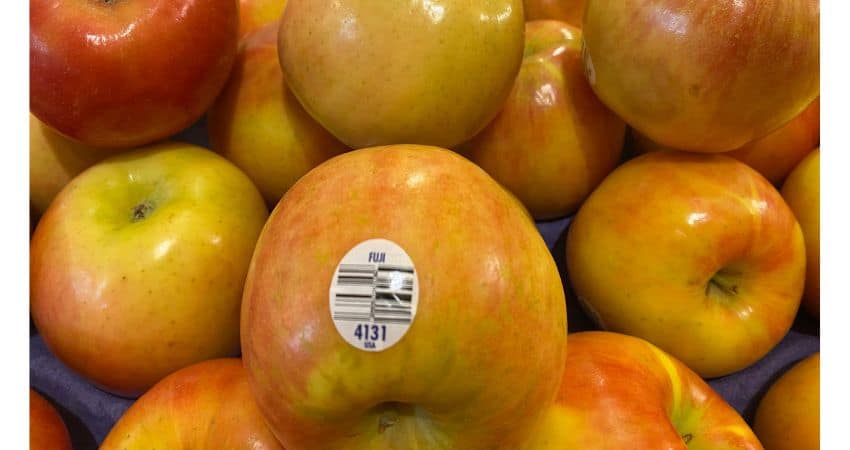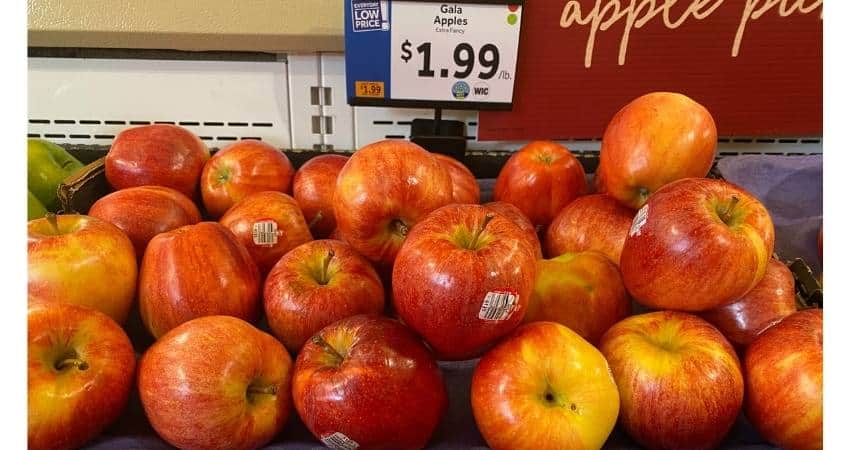Fuji vs. Gala Apples – A Complete Comparison
You may have wondered about the differences between Fuji and Gala apples. Let’s take a close look at each apple.
Fuji Apples have a sweet taste with a slight tartness while Gala is sweet with no tartness. Fuji has a denser flesh than Gala and is more crispy. Both have yellow to pink to red coloring but Fuji is slightly more red than Gala.
This article will compare their tastes, textures, nutrients, colors and prices in complete detail. In addition, I’ll explain Fuji and Gala’s uses for eating or baking.
What Are Fuji and Gala Apples?

As a Certified Health Coach many clients ask me about food comparisons including apples. I purchase and consume an apple everyday. Therefore, I have researched this topic in the past and present. Let’s examine them closely.
Thanks to selective and crossbreeding, we now have thousands of apple varieties to choose from ((Milwaukee Journal Sentinel: Comparing apples to apples)). Both Fuji and Gala apples were bred in the 20th century. Let’s learn a bit more about their origin to understand why they’re so different ((Wikipedia: Fuji (apple) )).
What are Fuji Apples?
Fuji Apples originated from Japan and were discovered in the 1930s but didn’t come to the world market until 1962. They are a cross between 2 American apples. Japanese farmers crossbred the Red Delicious and Ralls Janet apples to create the Fuji apple.
What Are Gala Apples?
Gala apples were first bred in the 1930s. J.H. Kidd produced them in New Zealand in 1934. He crossed the Golden Delicious and Kidd’s Orange Red apples to create the Gala apple.
It is one of the more popular varieties in the United States. For good reason, their versatile and are good for snacking and cooking ((Washington Apple Commission: Apple Varieties)).
Fuji and Gala Apples Availability
Fuji apples are harvested in late October, whereas Gala apples are harvested in early September. Although thanks to modern food preservation techniques and imports, both types are available year-round. Of course, the apples taste best when they’re plucked fresh from the tree ((North Carolina State: Malus domestic: Fuji Apple)).
A Gala apple will taste the best throughout September. A Fuji apple has the crispiest texture in late October and early November. If you’re buying them out of season, the flavor and texture can vary much.
Fuji vs Gala Apples: Taste, Texture and Colors
Although these apples are both popular cultivars, they have some essential differences which might make one or the other the better option for you. Let’s examine the differences:
| Gala Apples | Fuji Apples | |
| Texture | Soft, dense and crisp | Hard and crisp |
| Taste | Sweet, no hint of tartness | Sweet and a little tart |
| Color | Yellow, pink and red | Yellow, pink and red |
| Nutrients | More calories, less sugar | More sugar and iron |
Taste
Both Fuji and Gala apples are low in acid, so they aren’t very tangy. However, Fuji and Gala apples are significantly sweeter because of their higher sugar content ((NC State Extension: Malus domestic Gala)).
The aroma is quite different. Fuji apples are often described as warm, spicy, and sweet. Gala apples have more of a floral and creamy taste.
My Poll and Taste Test at Home
I wanted to conduct original research and get the opinion of real people like you. Therefore, I contacted my clients, readers and members of food groups I belong to. I asked them which of the two apples they preferred.
- 44% said they preferred the taste of Fuji.
- 39% said they preferred the taste of Gala.
- 17% said they had no preference, or it depended on their mood.
I set up a blind test taste at home. Five people were given a full apple of each to bite into and an individual slice of each to taste again.
Three of the five, 60%, chose the Fuji apple over the Gala. Therefore, Fuji was the winner in my poll and blind taste test.
Texture
Fuji apples have denser flesh than Gala apples. This, in addition to the slightly thicker skin, gives the Fuji apple a crispier texture. Gala apples have slightly higher water content and more fiber ((Washington State University: Fuji)).
Therefore, they’re more refreshing and hydrating. It’s the kind of apple you love to eat straight from the fridge when it’s scorching hot outside ((Cornell University: Apple expert explains the history of Gala vs. Red Delicious plus what to expect from the 2018 season)).
Colors
Darker apples tend to have more polyphenols. Both Fuji and Gala apple colors range from yellow to pink and red.
On average, Fuji apples are slightly redder, so it’s safe to assume they contain marginally more polyphenols.
See how Gala compared to another famous apple in my article, Gala Vs Empire Apples – The Differences.

Fuji and Gala Apples: Eating, Baking and Cooking
Of course, both Gala and Fuji apples taste amazing when fresh. You can eat them as a snack in between meals, for breakfast or before going to bed. Since Fuji apples are sweeter, juicier, and often crispier, they taste a bit better.
Since both apples have low acidity, you can use them in pretty much any recipe. And since Fuji apples are denser and crispier, they’ll break down less when heated ((Yale University: Fuji Apple)).
Fuji apples are better if you’re looking for freshness in your apple pie and apple crisp. They’ll also add more sweetness, so you can use less table sugar.
Gala apples will break down more. Therefore, they’re perfect for apple sauce, apple crumble and any other dish tasting better with soft apples. For this reason, they’re not good for apple pies which needs to hold it together more for the filling.
Gala apples over ripen more quickly, but that’s a great thing for cooking. If you’ve ever cooked homemade tomato sauce with very ripe tomatoes, you’ll know what I mean.
Gala apples also taste better in salads because they’re less sweet. You can combine them with a sour or savory dressing for a delicious and refreshing summer salad.
Admittedly, you can use the two interchangeably, except with apple pie and crisp. Only remember that Fuji apples will stay crispy after cooking.
Fuji and Gala Apples Nutrition
The following table compares the nutrients of Gala and Fuji Apples:
| Nutrient | Gala Apple (1 medium apple) | Fuji Apple (1 medium apple) |
| Calories | 94 | 80 |
| Carbohydrates | 23 g | 24 g |
| Fiber | 3.2 g | 3.3 g |
| Sugar | 16 g | 18 g |
| Potassium | 163 mg | 172 mg |
| Calcium | 10.78 mg | 11.06 mg |
| Iron | 0.09 mg | 0.16 mg |
| Vitamin C | 4.8 mg | 4.8 mg |
Nutrient Sources (Nutrition Value: Apples, raw, with skin, gala))1
There’s not much difference between Fuji and Gala nutrients.
Fuji Apples are better than Gala due to their lower calories, more potassium, calcium and 80% more iron than Gala. Fuji is more crispy, tastes sweeter and is better for making apple pie than Gala.
Other than that, they are pretty much even and similar in carbohydrates, fiber and vitamin C.
Did you know apples’ skin which contains many antioxidants? In addition, the skin contains half the fiber. Therefore, it’s wise to leave the skin on the apple, whether eating them whole or adding them to smoothies.
In fact, the apple’s antioxidants are so powerful, scientists have calculated it’s equal to more than 1,500 milligrams of vitamin C.
Fuji and Gala Apples Cost
Both Fuji and Gala apples cost about the same. But this depends on your local store. Since Gala apples ripen more quickly, you’ll see them on sale more often. Fuji apples stay fresh for longer, so it’s easier to buy them.
To conduct more research I visited my local supermarket to check the prices of each apple. I found the following costs:
- Fuji apples:
- $1.99 per pound
- Gala apples:
- $1.99 per pound
Both Fuji and Gala apples cost were the same, $1.99 per pound. These prices were for non-organic varieties.

If you have any questions to ask me about this article don’t hesitate to comment below or email us. You can find an email on our contact page.
Read Next – Another Apple vs Apple Article!
Fuji Apple vs McIntosh – What’s The Difference?
Empire vs Red Delicious Apples: A Complete Comparison
- Nutrition Value: Apples, with skin, fuji, raw [↩]
